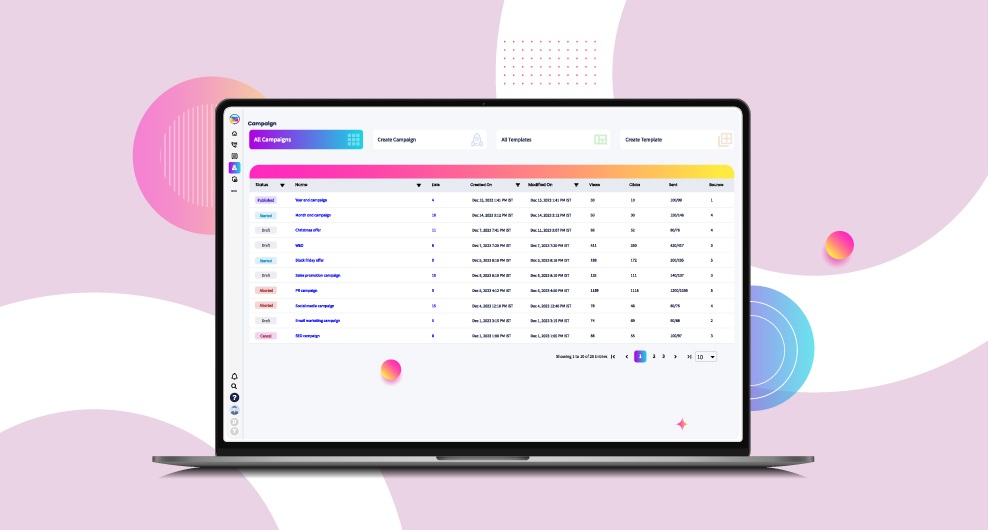Table of Contents
When you consider it, marketing presents a significant challenge. It demands precise timing, messaging, and offers to effectively reach customers. Getting it wrong can lead to lost sales to competitors.
One major obstacle in marketing is email bounce backs, which can hinder the effectiveness of email campaigns. The average bounce back rate across industries is 10.29 percent, meaning that out of 1,000 emails sent, over 100 might bounce. This high bounce rate can significantly impact campaign performance, highlighting the importance of addressing this issue.
What is an email bounce back?
An email bounce back, also known as a bounced email or a bounce, occurs when an email is not delivered to the intended recipient and is returned to the sender’s email server. This can happen for various reasons, such as an invalid email address, a full inbox, or issues with the recipient’s email server.
Bounced emails are categorized as either “hard bounces” or “soft bounces”:
- Hard Bounce: A hard bounce occurs when an email cannot be delivered due to a permanent issue, such as an invalid email address or a domain that does not exist. These issues are usually not resolved by resending the email and typically require corrective action, such as updating the email address or removing it from the mailing list.
- Soft Bounce: A soft bounce occurs when an email cannot be delivered temporarily due to a temporary issue, such as a full inbox or a server that is temporarily down. Soft bounces may resolve themselves, and the email may be delivered successfully if resent later.
Bounce backs are important to monitor and address because they can negatively impact email deliverability and sender reputation. High bounce rates can indicate problems with the email list or the email sending practices, which can lead to emails being flagged as spam or blocked by email service providers.
7 proven ways to reduce email bounce backs
Reducing email bounce backs is a multifaceted process that requires a combination of strategic planning, meticulous list management, and ongoing monitoring. Here’s a detailed breakdown of each strategy to help you reduce bounce rates and enhance the effectiveness of your email marketing campaigns:
- Use Double Opt-In: A double opt-in process involves sending a confirmation email to new subscribers asking them to verify their email address by clicking a link. This extra step helps ensure that the email address is valid, and that the subscriber is genuinely interested in receiving emails from you. Implementing double opt-in can significantly reduce the likelihood of invalid email addresses being added to your list.
- Regularly Clean Your Email List: Over time, email addresses can become invalid due to changes in job roles, domain changes, or simply because the subscriber is no longer interested. Regularly cleaning your email list involves removing these invalid addresses to improve deliverability and reduce bounce rates. Use email validation tools to identify and remove invalid addresses from your list.
- Segment Your Email List: Segmenting your email list involves dividing your subscribers into different groups based on factors such as demographics, purchase history, or engagement level. By sending targeted emails to each segment, you can increase relevancy and reduce the likelihood of bounces. For example, you can send a special promotion to a segment of subscribers who have previously purchased from you, increasing the chances of engagement.
- Monitor Bounce Rates: Monitoring your bounce rates is essential for identifying and addressing potential issues. Keep an eye on your bounce rates regularly and investigate any sudden spikes or patterns. High bounce rates could indicate problems with your email list or sending practices that need to be addressed. For example, if you notice a high bounce rate for a specific campaign, it may indicate that the email content or targeting needs to be adjusted.
- Use a Reliable Email Service Provider (ESP): Choosing the right ESP is crucial for ensuring the deliverability of your emails. A reputable ESP will have built-in features to help reduce bounce rates, such as email list management tools and spam filter monitoring. They will also provide guidance on best practices to improve deliverability and reduce the likelihood of your emails being marked as spam.
- Authenticate Your Emails: Email authentication protocols such as SPF, DKIM, and DMARC help verify the authenticity of your emails and prevent spoofing or phishing attempts. Implementing these protocols can help improve deliverability and reduce the chances of your emails being marked as spam. Work with your IT team or ESP to set up and configure these protocols correctly.
- Optimize Email Content and Design: The content and design of your emails can also impact your bounce rates. Ensure that your emails are clear, relevant, and engaging to your subscribers. Avoid using spammy language or excessive formatting, as these can trigger spam filters and increase bounce rates. Additionally, optimize your emails for mobile devices to improve readability and deliverability.

By implementing these strategies, you can effectively reduce email bounce backs and improve the overall success of your email marketing campaigns.
Conclusion
Reducing email bouncebacks hinges on mastering both the technical components of your email marketing campaigns and gaining a deep understanding of your audience.
Begin by addressing the technical aspects:
- Avoid using free sender domains.
- Regularly clean your email list to remove inactive and disengaged accounts.
- Adhere to email marketing best practices to avoid triggering spam filters.
After ensuring the technical aspects are in order, shift your focus to your audience:
- Segment your email list and personalize content for each segment.
- Send emails at times that are most convenient for your customers.
- Test different signup incentives, subject lines, copy, and creatives to determine what drives the highest engagement.
By implementing these strategies with the right email marketing software like YoroConnect, you can significantly reduce bouncebacks, leading to increased ROI from your email marketing efforts.




